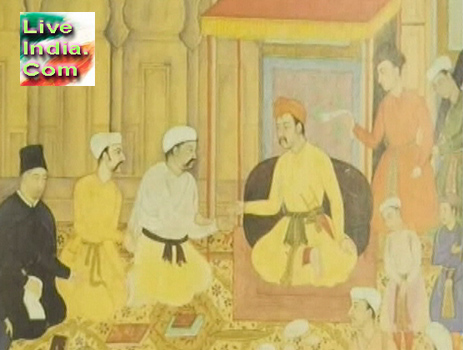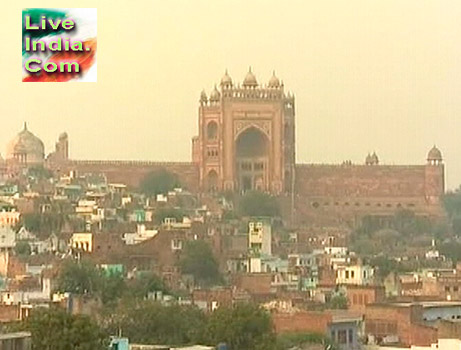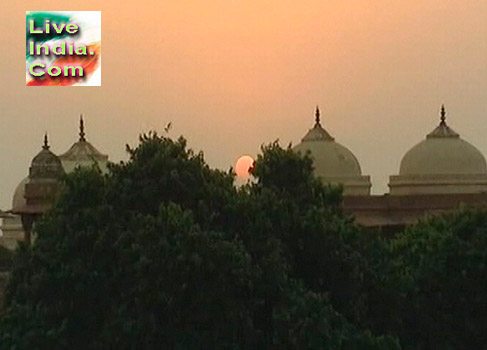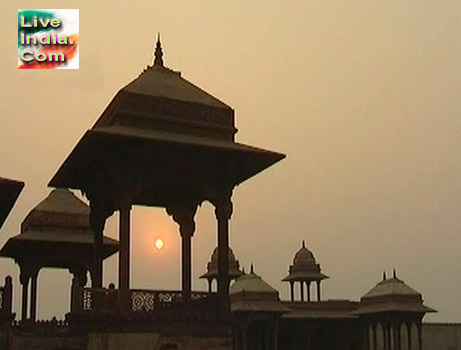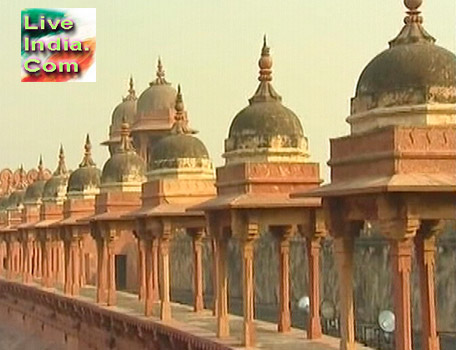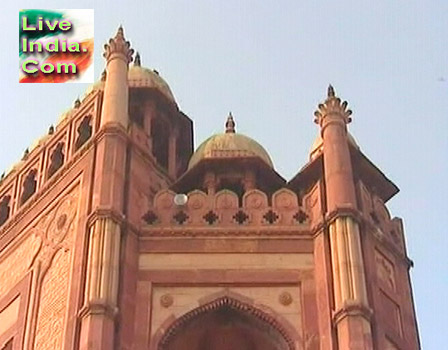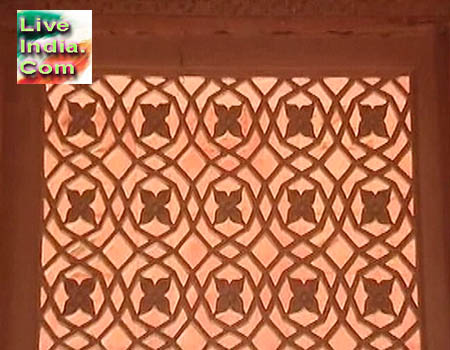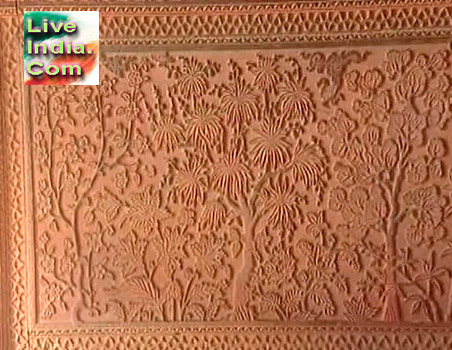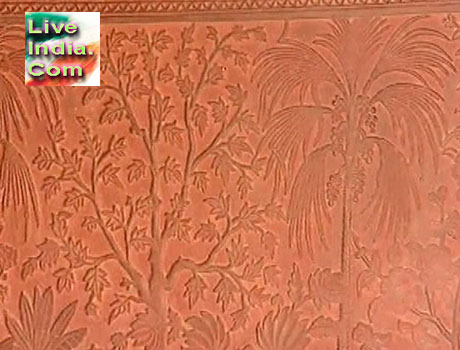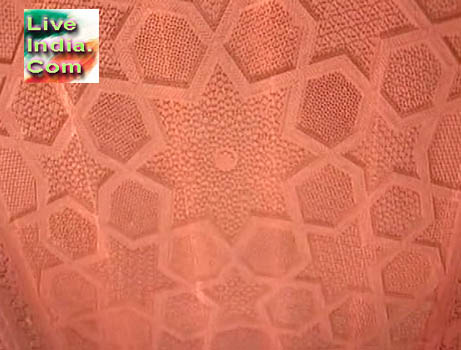Fatehpur
Sikri (built mostly 1571-86)
Fatehpur Sikri, the "City
of Victory", sits 35 kilometers from Agra on a low hill of the Vindhya
mountain range. Before the reign of Akbar (1556-1605), the Mughal King
who built Fatehpur Sikri, the site of the future city had already earned
an auspicious reputation. Babar, the founder of the Mughal Dynasty and
Akbar's grandfather, had won a battle here over Rana Sanga of Mewar. In
gratitude he named the area Shukri, which means "thanks". In Akbar's time
the site was occupied by a small village of stonecutters and was the home
of Shaikh Salim Chishti, a Muslim astrologer and Sufi Saint. In 1568 Akbar
visited the Shaikh to ask for the birth of an heir. The Shaikh replied
that an heir would be born soon. Sure enough, Akbar's wife gave birth to
a boy on August 30, 1569. In gratitude, Akbar named the boy Salim after
the astrologer, and, two years later decided to move the capital to Sikri.
Of course, the decision
to build a new capital at Sikri was determined by more than sentiment.
It was a strategic location in Rajasthan that put Akbar and his armies
closer to the Gujarat region--the next object of Akbar's expansionist dreams.
Gujarat was desirable because its coastal cities were ideally suited to
take advantage of the lucrative trade to Arab lands.
Construction of the new
capital began in earnest in 1571 and continued for about fifteen years.
During much of this time Akbar made the area his home, but strangely, in
1586, Akbar abandoned his new capital forever. The reasons are not entirely
clear, but the most plausible explanation is that Akbar needed to move
his base of operations to wage the war against Kabul, which he occupied
in 1585, and Kandahar, which fell in 1595.
| After Akbar's departure
the city was used only sparingly in the coming centuries. In the early
17th century it became the home of several queen mothers. In 1619 Emperor
Jahangir camped here for three months while a plague raged in nearby Agra.
Ninety years later, the city was refurbished to host the coronation of
Muhammad Shah (1709-48). After that, the city was largely abandoned until
Lord Curzon, Viceroy of India for the British from 1898 to 1905, sponspored
an archaeological survey and restoration efforts.
In present times the city
has become one of the chief tourist attractions of India. However, it is
impossible to capture in pictures a single iconic image of the city, in
the way that the Taj Mahal can be framed in its totality in the viewfinder
of any camera. Fatehpur Sikri is so large and decentralized that the city
can only be experienced as a series of changing surroundings as one travels
from courtyard to courtyard. There are no broad boulevards or landmark
buildings that can be constantly kept in view when experiencing the city.
At Fatehpur Sikri, there are very few buildings that can be seen from all
four sides in isolation--among them the Diwan-i-Khas and the Sonakra Makan.
Most buildings are fused together in such a way that there are a multitude
of routes to reach any point. It is almost if the figure-ground of a modern
city is reversed: open spaces are non-continuous islands in a network of
buildings that flow together like streets. |
|
The mystical beauty of the
Mughal styles of the architecture of the Fatehpur Sikri provides a greater
charm to your Tour to Uttar Pradesh. Perhaps one of the lesser known tourist
attractions of the Mughal reign, a trip to Uttar Pradesh can never be said
to be complete if your tour itinerary to Uttar Pradesh does not include
a Tour to Fatehpur Sikri. Located at a distance of around 26 kms to the
west of the main city of Agra, a trip to this ancient land mark reveals
much of the History of Fatehpur Sikri and also throws light on the history
of the Mughals in India.
The History of Fatehpur Sikri
dates back to the reign of Akbar, arguably one of the greatest and most
charismatic rulers amongst the Great Mughals. Blessed with almost all the
joys of life, the great Mughal emperor was, however, without an heir to
the throne. It was this worry that led him to travel barefoot to Ajmer
to seek the blessings of the great Sufi saint, Sheikh Salim Chisti, who
eventually blessed the emperor with an heir to the Mughal throne in India,
who was to be later known as Jahangir.
The entirety of the complex
of Fatehpur Sikri was built as a kind of homage to this great Sufi saint,
after whom the city was also named, an act that was a mark of gratitude
shown by Akbar. According to modern historians, work on the construction
of the complex began around the year 1571, a time when the prowess of the
Mughals was at their peak. Once the construction of the fort was complete,
the entirety of the complex of the Fatehpur Sikri began to serve as an
additional capital to that of the Red Fort at Agra, which had till now
been regarded as the only capital of the Mughal Rule.
The period of the Mughal
rule with their capital at Fatehpur Sikri is regarded by modern historians
as one of the most important periods in the annals of the History of India.
It is said that many of the important administrative, financial as well
as the military reforms of the Mughal era was conceptualized and implemented
during this period.
It is said that the fort
was abandoned at around the year of 1585, when a severe scarcity of water
forced the people of the fort to look for a new settlement. Now one of
the most popular tourist attractions of Uttar Pradesh, a trip to the Fatehpur
Sikri in Uttar Pradesh in India is a definite must include since the monument
is today a part of the prestigious World Heritage Sites as declared by
UNESCO.
At Sikri, the various
royal palaces have been built in Gujarati and Rajasthani architectural
styles, using ornate columns, fanciful jali work (intricately perforated
decorative stone screens), sumptuous carving, and surface ornamentation.
Most of the buildings located inside Fatehpur Sikri are a unique blend
of architectural traditions flourishing at that time in India. These small
palaces are largely a sequence of connected rectangular courtyards; these
are aligned with the polar axes and so have to be grouped in a staggered
formation across, the top of the narrow diagonal ridge. The overwhelmingly
Hindu architectural vocabulary, however, cannot conceal the Islamic norms
followed in the large-scale planning that is supposed to have derived from
Arab and Central Asia tent compartments! |



